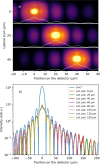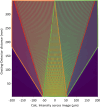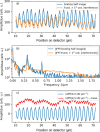High magnification optical imaging systems for the characterization of soft X-ray focii
- PMID: 41071638
- PMCID: PMC12591071
- DOI: 10.1107/S160057752500774X
High magnification optical imaging systems for the characterization of soft X-ray focii
Abstract
We present a series of novel X-ray imaging systems designed specifically for the soft X-ray energy range, optimized for operation in ultra-high-vacuum environments and compactness. These systems achieve micrometre-level spatial resolution with high collection efficiency of visible light by using high numerical aperture optics. Comprehensive characterization of the systems' response was performed, including linearity assessments and X-ray sensitivity measurements, across X-ray photon densities ranging from 1 nJ m-2 to 10-4 nJ m-2. The imaging system was employed for caustic measurements to characterize the X-ray focal spot and to demonstrate its capabilities. Finally, grating interferometry was used to measure the wavefront distortion, yielding a pitch resolution as fine as 3.1 µm. These results underscore the system's potential for high-resolution soft X-ray imaging and wavefront characterization applications.
Keywords: Talbot imaging; focus characterization; imaging; micrometric resolution; soft X-rays.
open access.
Figures















References
-
- Abela, R., Alarcon, A., Alex, J., Arrell, C., Arsov, V., Bettoni, S., Bopp, M., Bostedt, C., Braun, H.-H., Calvi, M., Celcer, T., Craievich, P., Dax, A., Dijkstal, P., Dordevic, S., Ferrari, E., Flechsig, U., Follath, R., Frei, F., Gaiffi, N., Geng, Z., Gough, C., Hiller, N., Hunziker, S., Huppert, M., Ischebeck, R., Jöhri, H., Juranic, P., Kalt, R., Kaiser, M., Keil, B., Kittel, C., Künzi, R., Lippuner, T., Löhl, F., Marcellini, F., Marinkovic, G., Ozkan Loch, C., Orlandi, G. L., Patterson, B., Pradervand, C., Paraliev, M., Pedrozzi, M., Prat, E., Ranitovic, P., Reiche, S., Rosenberg, C., Sanfilippo, S., Schietinger, T., Schmidt, T., Schnorr, K., Svetina, C., Trisorio, A., Vicario, C., Voulot, D., Wagner, U., Wörner, H. J., Zandonella, A., Patthey, L. & Ganter, R. (2019). J. Synchrotron Rad.26, 1073–1084.
-
- Alaruri, S. D. (2018). Int. J. Meas. Technol. Instrum. Eng.7, 17–37.
-
- Baumann, T. M., Boll, R., De Fanis, A., Grychtol, P., Ilchen, M., Jastrow, U. F., Kato, M., Lechner, C., Maltezopoulos, T., Mazza, T., Montaño, J., Music, V., Ovcharenko, Y., Rennhack, N., Rivas, D. E., Saito, N., Schmidt, P., Serkez, S., Sorokin, A., Usenko, S., Yan, J., Geloni, G., Tanaka, T., Tiedtke, K. & Meyer, M. (2023). J. Synchrotron Rad.30, 662–670. - PMC - PubMed
-
- Born, M. & Wolf, E. (1999). Principles of Optics. Cambridge University Press.
-
- Follath, R., Flechsig, U., Wagner, U. & Patthey, L. (2019). Proceedings of the 39th International Free Electron Laser Conference (FEL2019), 26–30 August 2019, Hamburg, Germany, pp. 535–537.
Grants and funding
LinkOut - more resources
Full Text Sources

